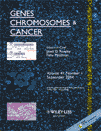Aberrations of breast cancer susceptibility genes occur early in sporadic breast tumors and in acquisition of breast epithelial immortalization
Abstract
In the search for early deletion targets in sporadic breast cancer, the analysis of TP53, BRCA1, BRCA2, and ATM revealed loss of heterozygosity (LOH) in tumor cells at 1 or more genes in 18 of 24 cases examined. Notably, in more than 60% of such tumors, LOH was detectable in morphologically normal terminal ductal lobular units (TDLUs) adjacent to carcinoma (LOHint). At BRCA2 and ATM, LOHint was most frequent, particularly in TDLUs of women ≤ 50 years old (7 of 10). In a novel preneoplastic model system, declining expression levels observed with increasing passage in culture supported the postulate that during the acquisition of continuous growth, elimination of these genes at an early stage confers a distinct selective advantage. The intimate role of these genes in DNA repair and their early deletion has implications for the possible transforming effects of DNA-damaging agents on unexcised breast tissue harboring LOHint within breast cancer patients. © 2004 Wiley-Liss, Inc.




